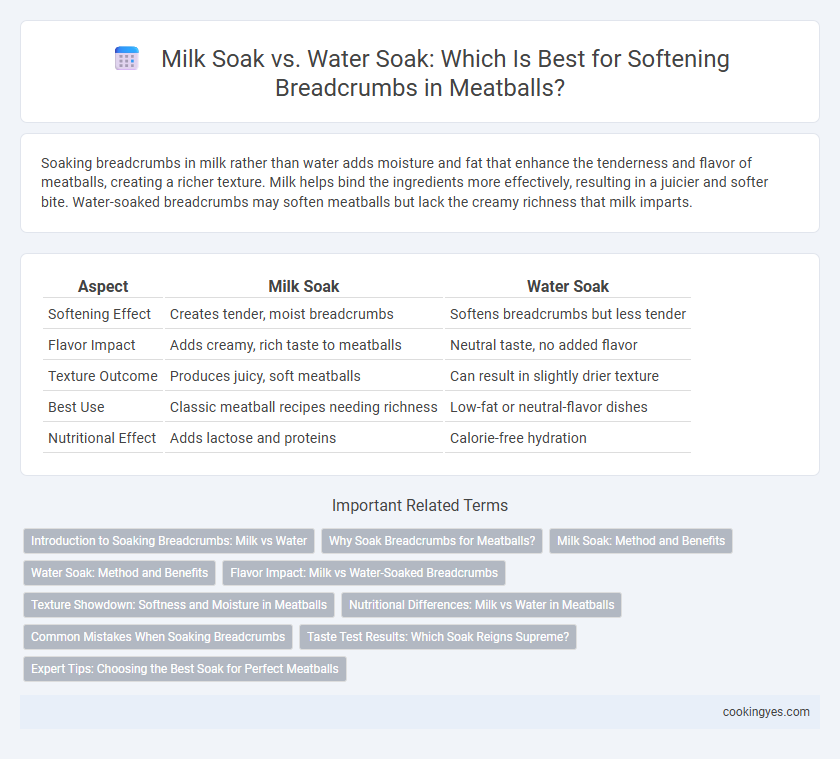Soaking breadcrumbs in milk rather than water adds moisture and fat that enhance the tenderness and flavor of meatballs, creating a richer texture. Milk helps bind the ingredients more effectively, resulting in a juicier and softer bite. Water-soaked breadcrumbs may soften meatballs but lack the creamy richness that milk imparts.
Table of Comparison
| Aspect | Milk Soak | Water Soak |
|---|---|---|
| Softening Effect | Creates tender, moist breadcrumbs | Softens breadcrumbs but less tender |
| Flavor Impact | Adds creamy, rich taste to meatballs | Neutral taste, no added flavor |
| Texture Outcome | Produces juicy, soft meatballs | Can result in slightly drier texture |
| Best Use | Classic meatball recipes needing richness | Low-fat or neutral-flavor dishes |
| Nutritional Effect | Adds lactose and proteins | Calorie-free hydration |
Introduction to Soaking Breadcrumbs: Milk vs Water
Soaking breadcrumbs in milk enhances moisture retention and adds richness, contributing to a tender, flavorful meatball texture. Water-soaked breadcrumbs primarily hydrate without altering taste, producing a lighter but less creamy bite. Choosing milk or water impacts the final meatball's succulence and mouthfeel based on desired flavor profiles.
Why Soak Breadcrumbs for Meatballs?
Soaking breadcrumbs in milk enhances meatball tenderness by allowing the breadcrumbs to absorb moisture, creating a binder that retains juices during cooking. Milk's fat and proteins add richness, improving texture and flavor compared to water, which only hydrates without enriching. This moisture absorption prevents dense, dry meatballs and ensures a soft, cohesive bite.
Milk Soak: Method and Benefits
Soaking breadcrumbs in milk softens their texture, allowing them to absorb moisture evenly and create a tender meatball interior. Milk's fat content enriches the meat mixture, enhancing flavor complexity and preventing dryness during cooking. This method produces juicier, more cohesive meatballs compared to water-soaked breadcrumbs, which lack the same binding and enriching properties.
Water Soak: Method and Benefits
Soaking breadcrumbs in water softens their texture effectively by allowing them to absorb moisture without altering the meatball's flavor, making them ideal for a neutral base in recipes. The method involves submerging breadcrumbs in a measured amount of room-temperature water until fully hydrated, ensuring the meat mixture remains tender and moist. Water-soaked breadcrumbs improve meatball juiciness and help maintain structural integrity during cooking, unlike milk soak which adds additional dairy flavor.
Flavor Impact: Milk vs Water-Soaked Breadcrumbs
Milk-soaked breadcrumbs impart a richer, creamier flavor to meatballs due to the fat and sugars in dairy that enhance browning and moisture retention. In contrast, water-soaked breadcrumbs result in a blander taste and a drier texture since water lacks the fat and protein that contribute to flavor complexity. Choosing milk over water for soaking breadcrumbs intensifies the overall savory profile and juiciness of meatballs.
Texture Showdown: Softness and Moisture in Meatballs
Soaking breadcrumbs in milk enhances meatball texture by adding creaminess and retaining moisture, resulting in a tender, juicier bite. Water-soaked breadcrumbs absorb less fat and flavor, leading to a firmer texture with a drier interior. Milk's fat and proteins play a crucial role in softening the breadcrumb matrix, improving overall mouthfeel and preventing meatballs from becoming dense or crumbly.
Nutritional Differences: Milk vs Water in Meatballs
Using milk instead of water to soak breadcrumbs in meatballs enhances the nutritional profile by adding protein, calcium, and vitamins such as B12 and D. Milk's fat content also contributes to a richer texture and improved moisture retention, resulting in juicier meatballs compared to water-soaked breadcrumbs. Water, while calorie-free and neutral, lacks these nutrients and does not contribute to the flavor or nutritional value of the meatballs.
Common Mistakes When Soaking Breadcrumbs
Using water to soak breadcrumbs often results in a bland texture, while milk enhances flavor and adds moisture, creating a richer meatball. A common mistake is soaking breadcrumbs too long, causing them to become mushy and affecting the meatball's structure. Another error is using cold liquid, which hinders proper absorption, whereas warm milk helps achieve the ideal consistency for tender, juicy meatballs.
Taste Test Results: Which Soak Reigns Supreme?
Milk soak for breadcrumbs enhances meatball texture by adding creaminess and richer flavor, while water soak results in a lighter, less flavorful crumb. Taste test results reveal milk-soaked breadcrumbs create juicier, more tender meatballs with a subtle sweetness that complements savory spices. Water-soaked breadcrumbs produce a drier bite with a neutral taste, making milk the preferred soaking liquid for optimal meatball flavor and softness.
Expert Tips: Choosing the Best Soak for Perfect Meatballs
Milk soak enhances breadcrumbs by adding moisture and richness, resulting in tender, juicy meatballs with a creamier texture. Water soak softens breadcrumbs but lacks the flavor depth, making it suitable for lighter, less rich meatball recipes. Experts recommend milk soak for balanced flavor and optimal moisture retention, crucial for achieving perfect, succulent meatballs.
Milk Soak vs Water Soak for softening breadcrumbs Infographic

 cookingyes.com
cookingyes.com